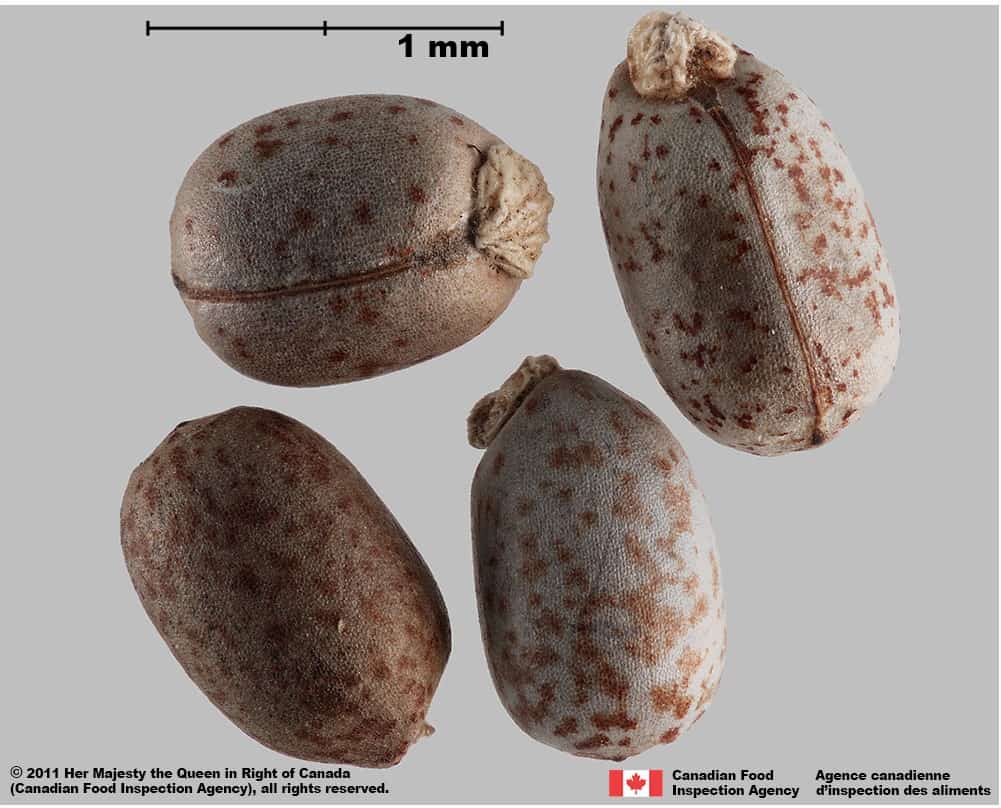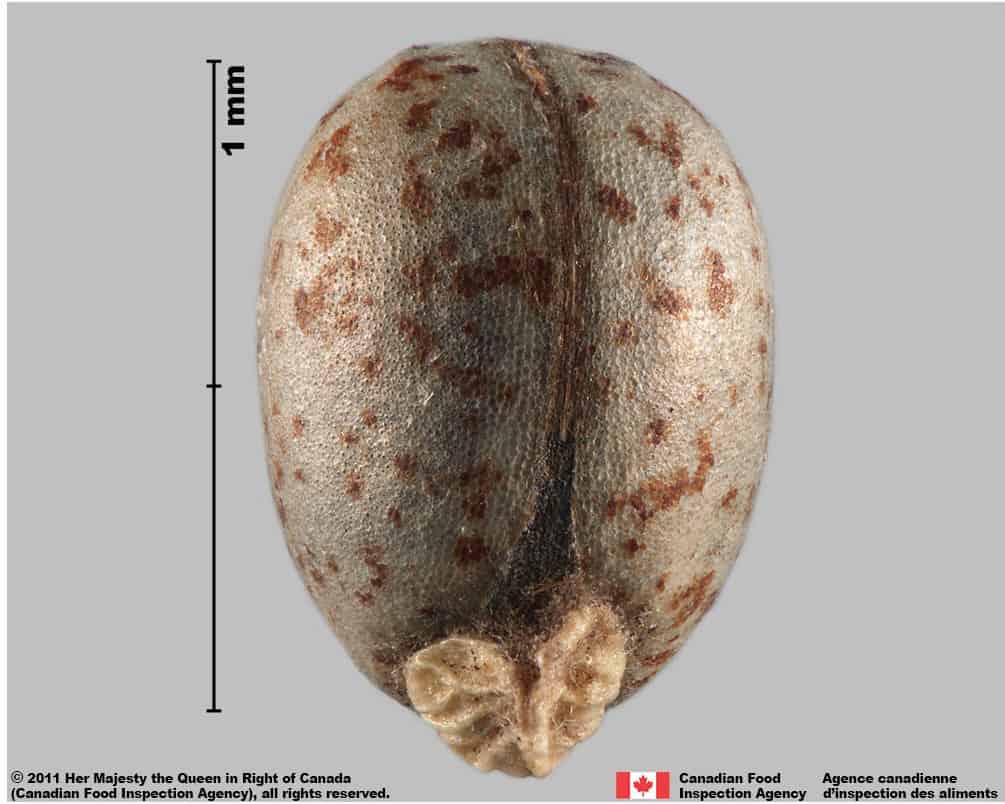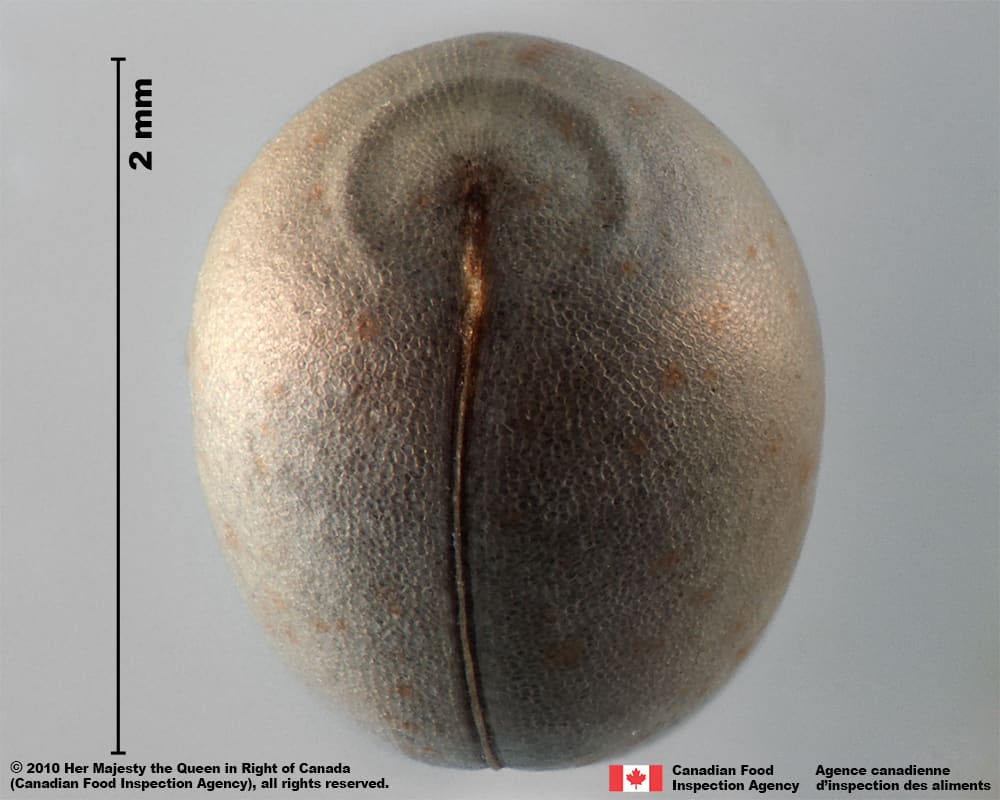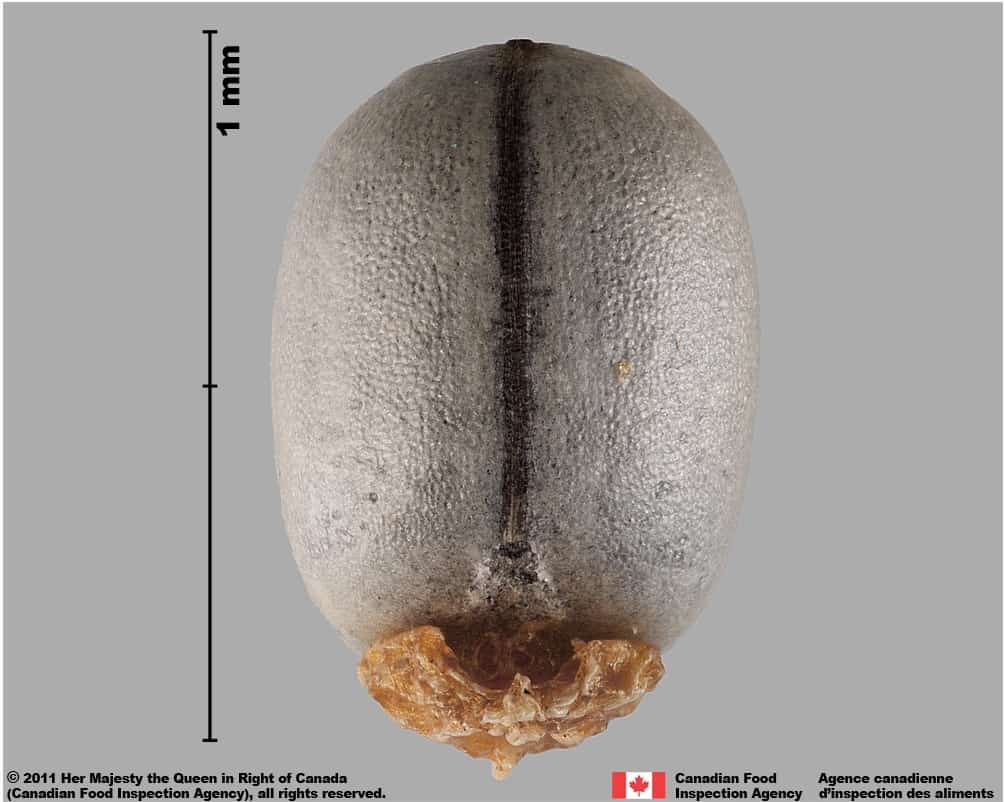Euphorbia esula
Overview
Aperçu
Regulation :
Remarques Réglementation:
- CFIA Weed Seeds Order - Class 2: Primary Noxious Weed Seeds
- Quarantine lists of countries e.g. Mexico *may be updated without notice
- USA Federal Noxious Weed Seed List
Regulation Notes:
Distribution :
Répartition :
Euphorbia esula is often confused with E. virgata. They are considered distinct, although related species (FNA 1993+; Riina et al. 2013). E. esula is native to a restricted range in Europe while E. virgata is much more widespread across Europe and temperate Asia. Some herbarium specimens of E. esula exist from North America; however, the species likely occurred sporadically in certain states in the late 1800s and early 1900s but did not persist. Therefore, E. esula is considered to be a waif in the North American flora. E. virgata is widespread in North America, occurring in all of Canada except Northwest Territories, Nunavut and Newfoundland and Labrador (Brouillet et al. 2010+; FNA 1993+; POWO 2022). E. virgata has been considered a noxious weed where it has been introduced in North America (Riina et al. 2013).
Habitat and Crop Association :
Habitat et Cultures Associées :
Cultivated fields, pastures, rangelands, fields, and roadsides (Royer and Dickinson 1999; Darbyshire 2003).
Economic Use, cultivation area, and Weed Association :
Utilisation économique, zone de culture et association de mauvaises herbes :
Duration of Life Cycle :
Durée du cycle vital:
Perennial
Dispersal Unit Type :
Type d’unité de dispersion :
Seed
General Information
RENSEIGNEMENTS GÉNÉRAUX
Euphorbia esula is a particular problem in the northern and central plains in the United Statesand in southern Saskatchewan and Ontario in Canada (Best et al. 1980; CABI 2022). It prefers coarse, disturbed soils and is aggressive in semi-arid habitats or overgrazed pastures where plant competition is reduced (Best et al. 1980; CABI 2022).
E. esula easily spreads through vegetative reproduction by shoots from lateral roots, and the plant is believed to produce compounds that reduce growth of competitors (Best et al. 1980; CABI 2022). Roots broken via cultivation will quickly resprout (Best et al. 1980).
Between 10-50 capsules per flowering shoot has been observed, and an average of 2500 seeds/m² was measured in a patch of E. esula in Canada (Best et al. 1980). Seed is dispersed by ejection from the capsule when ripe, up to a distance of five meters (Best et al. 1980). The seed may also be dispersed by water, animals and insects (Best et al. 1980). Seed in the soil may remain viable for up to eight years (CABI 2022).
.
Euphorbia esula infestation (L.L. Berry, Bugwood.org)
Identification
Identification
-
Capsule
Size
- Capsule length: 2.5 – 3.5 mm; width: 3 – 4.5 mm (FNA 1993+)
Shape
- Capsule is nearly globose with 3 rounded lobes, compressed slightly in edge view
Surface Texture
- Capsule is mostly smooth, granular textured around the outside of the lobes
Colour
- Capsule is straw yellow when mature
Other Features
- The lobes of the schizocarpic capsule separate at maturity with one seed inside, and each lobe splits open to release the seed once shed from the plant (FNA 1993+)

Euphorbia esula capsule


-
Seed
Size
- Seed length*: 2.1 – 3.0 mm; width: 1.5 – 1.9 mm
*Note: minimum and maximum of 20 seeds in a normal range of this species using image measurement (ISMA 2020)
Shape
- Oval-shaped seed, cylindrical in edge view
- Hilum end is compressed at an oblique angle, the other end is truncate
Surface Texture
- Seed surface appears smooth, but ridged reticulation is visible under high magnification (40x and higher)
- A longitudinal ridged raphe is on one side of the seed
Colour
- Seed colour is generally shiny, light grey with reddish-brown mottles, but seed colour can be grey, orange or brown without mottles
- Raphe is generally dark brown coloured
Other Features
Hilum and hilum area
- The hilum is usually covered by a wrinkled caruncle that is translucent yellowish or orange coloured
- Caruncle is generally persistent on the seed but can be removed during processing
Other than hilum
- The end opposite the hilum has a circular depression
- Seed colour may change with maturity, with brown seeds less mature than grey seeds, and mottled seeds being the most mature (Best et al. 1980)

Leafy spurge (Euphorbia esula) seeds







-
Embryo
Size
- Embryo partially fills the seed
Shape
- Embryo is spatulate shaped, in an axial position
Endosperm
- Endosperm is white coloured, soft textured

Leafy spurge (Euphorbia esula) seed, cross-section

Identification Tips
CONSEILS POUR L’IDENTIFICATION
Plants in the Euphorbiaceae are characterized by schizocarpic capsules, generally splitting apart explosively (FNA 1993+). The genus Euphorbia has the characteristic features of clustered flowers with large bracts beneath them and white latex sap (FNA 1993+). Seeds in this genus are generally oval or oblong shaped, cylindrical in edge view, with a longitudinal raphe ridge and a caruncle attached to one end. Seeds of Euphorbia esula are recognized by an oval shape, smooth surface texture, large wrinkled caruncle, and grey colour, generally mottled with brown. Seeds of other Euphorbia species may be a different shape, generally wrinkled or tuberculate texture and the caruncle may be absent.

Leafy spurge (Euphorbia esula) seed (grey)









Additional Botany Information
AUTRES RENSEIGNEMENTS BOTANIQUES
Flowers/Inflorescence
- Inflorescences are composed of clusters of a single pistillate flower, surrounded by 10-25 staminate flowers (FNA 1993+)
- Each flower cluster has 4 or more nectar producing glands under them (Best et al. 1980)
- Each flower cluster is supported by 2 large, leaf-like bracts on the flowering shoot (FNA 1993+)
Vegetative Features
- Leaves are attached alternately to the erect stem (Best et al. 1980)
- Leaves have entire margins and are narrow with mostly inconspicuous veins except for the midvein (FNA 1993+)
- At mid-leaf the margins are parallel (or almost) and have a pointed end, whereas, E. esula has a wider leaf with margins not parallel at the middle and has a more rounded end (FNA 1993+)
- All parts of the plant produce a white liquid latex when broken (Best et al. 1980)

Euphorbia esula flower (Chris Evans, University of Illinois, Bugwood.org)



Similar Species
ESPÈCES SEMBLABLES
Similar species are based on a study of seed morphology of various species, and those with similar dispersal units are identified. The study is limited by physical specimen and literature availability at the time of examination, and possibly impacted by the subjectivity of the authors based on their knowledge and experience. Providing similar species information for seed identification is to make users aware of similarities that could possibly result in misidentification.
Euphorbia cyparissias L. (cypress spurge)
E. cyparissias was grown as a garden ornamental, and has spread into pastures, fields and roadsides (Darbyshire 2003). Seeds are generally smaller than E. esula (length*: 1.7-2.5 mm; width: 1.2 – 1.6 mm) are light grey coloured without mottles, some seeds are brown coloured.
*Note: minimum and maximum of 20 seeds in a normal range of this species using image measurement (ISMA 2020)
Click to select species
Cliquez pour sélectionner les espèces

Euphorbia cyparissias
Comparison Window
Fenêtre de comparaison
MAIN SPECIES
ESPÈCES PRINCIPALES
Euphorbia esula

Euphorbia esula
Euphorbiaceae
Leafy spurge (Euphorbia esula) seeds
MAIN SPECIES
ESPÈCES PRINCIPALES
Euphorbia esula

Euphorbia esula
Euphorbiaceae
Leafy spurge (Euphorbia esula) seeds
MAIN SPECIES
ESPÈCES PRINCIPALES
Euphorbia esula

Euphorbia esula
Euphorbiaceae
Leafy spurge (Euphorbia esula) seeds (top right) and capsules (bottom left)
MAIN SPECIES
ESPÈCES PRINCIPALES
Euphorbia esula

Euphorbia esula
Euphorbiaceae
Leafy spurge (Euphorbia esula) seed (with caruncle and raphe)
MAIN SPECIES
ESPÈCES PRINCIPALES
Euphorbia esula

Euphorbia esula
Euphorbiaceae
Leafy spurge (Euphorbia esula) seed (grey)
MAIN SPECIES
ESPÈCES PRINCIPALES
Euphorbia esula

Euphorbia esula
Euphorbiaceae
Euphorbia esula seed (grey)
MAIN SPECIES
ESPÈCES PRINCIPALES
Euphorbia esula

Euphorbia esula
Euphorbiaceae
Leafy spurge (Euphorbia esula) seed with mottles
MAIN SPECIES
ESPÈCES PRINCIPALES
Euphorbia esula

Euphorbia esula
Euphorbiaceae
Leafy spurge (Euphorbia esula) seed (grey)
MAIN SPECIES
ESPÈCES PRINCIPALES
Euphorbia esula

Euphorbia esula
Euphorbiaceae
Euphorbia esula capsule
MAIN SPECIES
ESPÈCES PRINCIPALES
Euphorbia esula

Euphorbia esula
Euphorbiaceae
Leafy spurge (Euphorbia esula) seed, cross-section
SIMILAR SPECIES
ESPÈCES SEMBLABLES
Euphorbia cyparissias

Euphorbia cyparissias
Euphorbiaceae
Cypress spurge (Euphorbia cyparissias); seeds
SIMILAR SPECIES
ESPÈCES SEMBLABLES
Euphorbia cyparissias

Euphorbia cyparissias
Euphorbiaceae
Cypress spurge (Euphorbia cyparissias); seeds
SIMILAR SPECIES
ESPÈCES SEMBLABLES
Euphorbia cyparissias

Euphorbia cyparissias
Euphorbiaceae
Cypress spurge (Euphorbia cyparissias); seed
Need ID Help?
Besoin d’aide pour l’identification?
Reference(s)
Référence(s)
Best, K.F., Bowes, G.G., Thomas, A.G. and Maw, M.G. 1980. The biology of Canadian Weeds 39. Euphorbia esula L. Canadian Journal of Plant Science 60: 651-663.
Brouillet, L., Coursol, F., Meades, S. J., Favreau, M., Anions, M., Bélisle, P. and Desmet, P. 2010+. VASCAN, the database of vascular plants of Canada. http://data.canadensys.net/vascan/ Accessed February 21, 2022.
Centre for Agriculture and Bioscience International (CABI). 2022. Invasive Species Compendium, CAB International, Wallingford, UK. https://www.cabidigitallibrary.org/journal/cabicompendium Accessed February 21, 2022.
Darbyshire, S. J. 2003. Inventory of Canadian Agricultural Weeds. Agriculture and Agri-Food Canada, Research Branch. Ottawa, ON.
Flora of North America (FNA) Editorial Committee, eds. 1993+. Flora of North America North of Mexico [Online]. 22+ vols. New York and Oxford. Accessed December 29, 2022.
Government of Canada (GC). 2016. Canadian Weed Seeds Order. https://laws-lois.justice.gc.ca/eng/regulations/SOR-2016-93/page-2.html (English) https://laws-lois.justice.gc.ca/fra/reglements/DORS-2016-93/page-2.html (French)
Global Biodiversity Information Facility (GBIF) Secretariat. 2022. https://doi.org/10.15468/39omei Accessed via https://www.gbif.org/species/8203538 Accessed December 29, 2022.
International Seed Morphology Association (ISMA). 2020. Method for Seed Size Measurement. Version 1.0. ISMA Publication Guide.
Kartesz, J. T. 2011. The Biota of North America Program (BONAP). North American Plant Atlas. Chapel Hill, N.C., www.bonap.org/MapSwitchboard.html Accessed February 21, 2022.
Plants of the World Online (POWO). 2022. Facilitated by the Royal Botanic Gardens, Kew. Published on the Internet; http://www.plantsoftheworldonline.org/ Accessed April 27, 2022.
Riina, R., Peirson, J. A., Geltman, D. V., Molero, J., Frajman, B., Pahlevani, A., Barres, L., Morawetz, J. J., Salmaki, Y., Zarre, S., Kryukov, A., Bruyns, P. V. and Berry, P. E. 2013. A worldwide molecular phylogeny and classification of the leafy spurges, Euphorbia subgenus Esula (Euphorbiaceae). Taxon 62:316-342.
Royer, F. and Dickinson, R. 1999. Weeds of Canada and the Northern United States. The University of Alberta Press/Lone Pine Publishing, Edmonton, Alberta.
U.S. Department of Agriculture-Agricultural Research Services (USDA-ARS). 2022. Germplasm Resources Information Network (GRIN), https://npgsweb.ars-grin.gov/gringlobal/taxon/taxonomysimple.aspx Accessed February 21, 2022.




